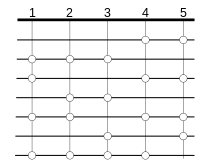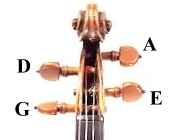Violin technique
The left hand regulates the sounding length of the strings by stopping them against the fingerboard with the fingers, producing different pitches.[2] In Morocco the violin is often held completely upright resting on the seated player's thigh with the left hand stabilizing the balance while fingering.Whatever the equipment, the player will usually aim to maintain a balanced, natural, and comfortable attitude, with the spine straight, especially the neck.The spot may be aggravated by an allergic reaction to nickel plating on the chinrest clamp hardware, or by microbial pathogens present on the instrument.[3] Keeping the left wrist relaxed and nearly "straight" allows freedom of finger motion, and reduces the chance of repetitive strain injury.Collapsing the wrist to "support" the violin with the heel of the hand is an unfortunate habit that many novice players fall into, and may take years of constant vigilance to overcome.Like any other unwarranted tension, it limits freedom of motion, and increases the risk of discomfort, while decreasing sound quality.It is useful to pay attention to the "square" formed by the right arm and bow, keeping it in a flat plane, and noticing which parts "lead" in string-crossing motions.Left-hand finger placement is a matter of the ears and hand, not the eyes, that is, it has strong aural and tactile/kinesthetic components, with visual references being only marginally useful.The blue bars on the sides of the chart represent the usual possibilities for beginners' tape placements, at 1st, high 2nd, 3rd (and 4th) fingers, or Bornoff pattern number two.The most common indication uses the letter name of the string: for example, if a composer wants a passage that would otherwise be taken on the D-string to be played on the G-string, they write "sul G" or "G Saite" or "auf G" or "G corde" (or simply, "on G") in the part.A well-made violin virtually points its sound pattern in different directions depending on slight variations in pitch.For the harmonics to produce the most consistent tone and volume, the bow needs to be making longer faster strokes.The right arm, hand, and bow are responsible for tone quality, rhythm, dynamics, articulation, and certain (but not all) changes in timbre.The bow is held in the right hand with the thumb bent underneath the frog to support it and the other fingers loosely touching the wood.Bowing action should be initiated and solely dependent upon movement of the right hand, not by the forearm, upper arm, and shoulder.Playing close to the bridge (sul ponticello) gives a more intense sound than usual, emphasizing the higher harmonics; and playing with the bow over the end of the fingerboard (sul tasto) makes for a delicate, ethereal sound, emphasizing the fundamental frequency.According to proponents of this style, these slight angles help create greater contact with the bridge and thus produce a fuller sound.In addition, some players have acquired the trick of playing fast pizzicato passages using two alternating fingers of the right hand.This position is especially helpful when the composer alternates between series of arco and pizzicato notes, because it allows the violinist to quickly and accurately switch styles.Violinists may also pluck a string with their left hand, denoted on written music as a "+" symbol above the note desired.Attaching a small rubber, wooden, or metal device called a "mute" to the bridge of the violin alters the tone, softening the instrument's sound by adding mass to the bridge and therefore reducing its ability to vibrate freely, decreasing volume and giving a more mellow tone, with fewer audible overtones.Parts to be played muted are marked con sord., for the Italian sordino or occasionally mit Dämpfer in German.Most fine tuners work by turning a small metal screw, which moves a lever that is attached to the end of the string.(Another type of tuner, using a screw to crimp a short segment of the string's afterlength near the tailpiece, is sometimes found, most generally on smaller instruments.)Fine tuners are usually recommended for younger players, fractional-sized instruments, those using high-tension or metal strings, or beginners.These techniques may be useful in performance, reducing the ill effects of an out-of-tune string until the arrival of a rest or other opportunity to tune properly.Capable violinists know how to straighten and center a bridge; this can easily be done under normal string tension without damage to the instrument.





ViolinViolinistsFiddleFiddlersHistoryMusical stylesAcousticsConstructionMaking andmaintenanceFamilypizzicatochinrestshoulder restCarnaticMoroccorepetitive strain injuryGeorge BornoffintonationintervalBornoffkinesthetictimbrebariolageJoseph Haydnstring quartet"Farewell" SymphonyPartita No.3 in E majorbagpipefolk musicDouble stoppingVibratoRomanticaural perceptionharmonicsfourthrhythmdynamicsarticulationbaroquefulcrumfundamental frequencySuzukiKreislerMarteléSpiccatoLegatoPaganiniLouréArpeggioTremoloCol legnoThe Planets SuitePiano Concerto No. 2Casey DriessenDarol AngerRushad EgglestonCrooked StillTurtle Island String QuartetIvan GalamianGustav MahlerBéla Bartókovertonestailpiecetuning forkorchestrasEarly musicauthentic performanceaccordionfifthsjust intonationequal-temperedf holesclassical musicscordaturaFirst Violin Concerto in E-flat majorDanse MacabreBowed string instrument extended techniquePitch (music)Sadie, StanleyTyrrell, JohnThe New Grove Dictionary of Music and MusiciansMacmillan PublishersLeopold MozartLeopold AuerSimon FischerMusical techniquesBowingDampingDouble stopExtended techniqueFingeringFinger substitutionFinger vibratoGlissandoMultiphonicPhrasingPositionSlappingStopped noteThumb positionWind instrumentsSaxophone techniqueCircular breathingEmbouchureFlutter-tonguingGrowlingHarmonica techniqueOverblowingSlap tonguingSplit toneTonguingPiano extended techniquesFinger tappingLuthéalThree-hand techniquePrepared pianoString pianoTack pianoBowed string instrumentsCello techniqueBartók pizz.Free bowingTwo bowsGuitarDownpickingFingerstyle